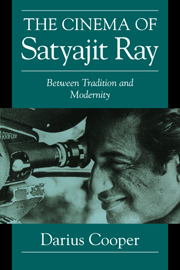Book contents
- Frontmatter
- Contents
- List of Illustrations
- Acknowledgments
- Introduction
- 1 Between Wonder, Intuition, and Suggestion: Rasa in Satyajit Ray's The Apu Trilogy and Jalsaghar
- 2 From Gazes to Threat: The Odyssean Yatra (Journey) of the Ray Woman
- 3 The Responses, Trauma, and Subjectivity of the Ray Purush (Man)
- 4 Satyajit Ray's Political Vision of the Doubly Colonized
- 5 From Newly Discovered Margins: Ray's Responses to the Center
- Notes
- Selected Bibliography
- Filmography
- Index
5 - From Newly Discovered Margins: Ray's Responses to the Center
Published online by Cambridge University Press: 05 June 2012
- Frontmatter
- Contents
- List of Illustrations
- Acknowledgments
- Introduction
- 1 Between Wonder, Intuition, and Suggestion: Rasa in Satyajit Ray's The Apu Trilogy and Jalsaghar
- 2 From Gazes to Threat: The Odyssean Yatra (Journey) of the Ray Woman
- 3 The Responses, Trauma, and Subjectivity of the Ray Purush (Man)
- 4 Satyajit Ray's Political Vision of the Doubly Colonized
- 5 From Newly Discovered Margins: Ray's Responses to the Center
- Notes
- Selected Bibliography
- Filmography
- Index
Summary
To the late but perennially alive Larry Schwartz, who loved India and Ray; Cuthbert Lethbridge, the finest individual Ray archivist; and the late Jason Fernandes, for fun-filled M.A. “Ray” Days at The Aakashvani
Introduction
Ray's humanism was endorsed by the bhadralok “center” (i.e., the Bengali middle class) to which he belonged. However, as the climate of India in general and Bengal in particular deteriorated in the 1990s on all fronts – political, cultural, social – and as this deterioration was felt in an everyday experience of “marginality,” Ray was forced into a search for an alternative authenticity to the notions of bhadralok centrality.
He started off by questioning the powerful fundamental beliefs of Hinduism, sanctioned by conniving bhadralok bureaucrats and fanatical religious zealots in Ganashatru (An Enemy of the People, 1989). This start was not auspicious, however, because the character chosen to question these “centrist” tendencies was not very convincing. Critic Asoke S. Viswanathan identifies accurately the confusions in Ray's characterization of Dr. Ashoke Gupta: “Where indeed is the cinematic isolation of the good doctor struggling to convince an insensitive, brute majority of the dangers of blind faith?” The characterization lacked conviction because the doctor's isolation emerged from living in an idealist's fool paradise. The same complaint may be leveled against Ray's depiction of Ananda Majumdar, the ailing father and founder of Anandnagar in his next film, Shakha Proshaka: Both men work in the public sphere of contemporary India, yet both seem completely unaware of the excesses that are ubiquitous there.
- Type
- Chapter
- Information
- The Cinema of Satyajit RayBetween Tradition and Modernity, pp. 213 - 234Publisher: Cambridge University PressPrint publication year: 2000

